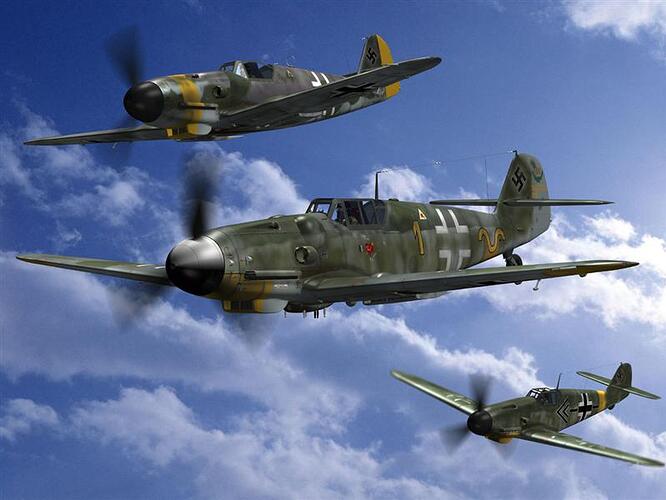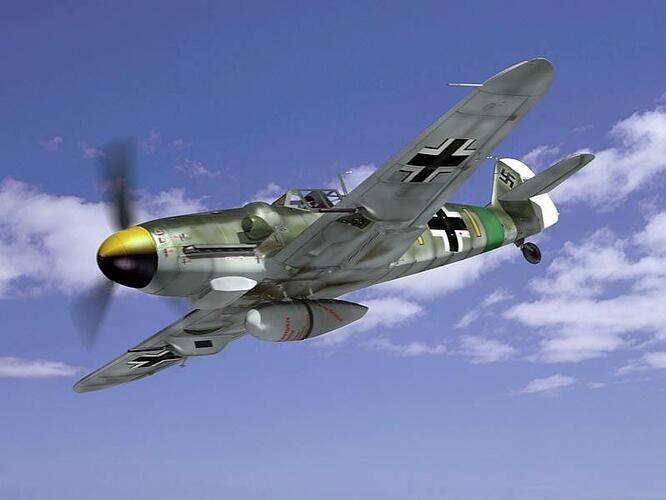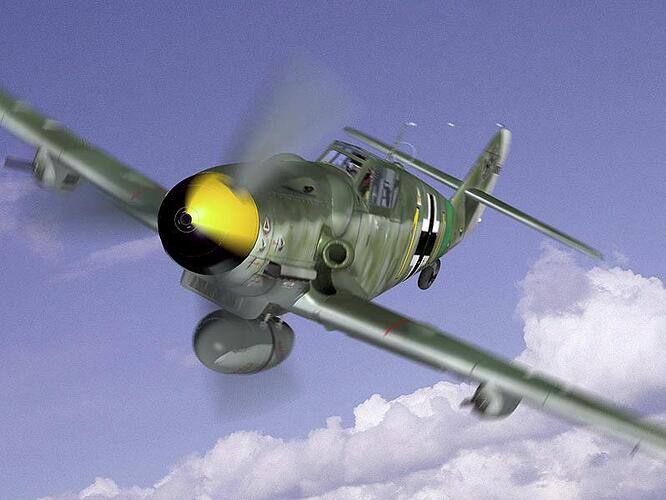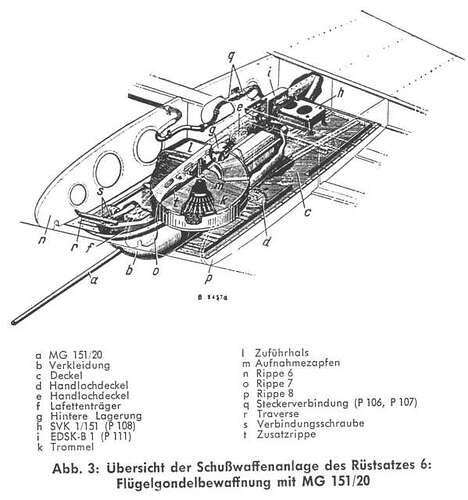Here are some more…
That 3d art from Harada( japanese ilustrator) is beautiful.
A little nuts those japs but sure they know how to draw with cad.
George that are a 300 liters tank, below the wings the Messer carry a WB-151 container with an Mg-151/20 Mauser cannon and 135 round.
squematic.
Hans Philipp

Hans Philipp was born on March 17, 1917 in Meissen in Saxony.
As a member of I./JG 76 (later to become II./JG 54), Philipp saw action over Poland and scored his first victory. Later during the Battle of Britain, Hans Philipp was made the Staffelkapitan of 4./JG 54.
Philipp soon gained a reputation for being a superb dogfighter, often preferring to battle it out with enemy fighters rather than bombers. Philipp’s successes in combat were recognized on November 4, 1940 when he was awarded the Knights Cross for his twenty victories to date. In typical celebratory fashion, he claimed a Hurricane ten days later.
On March 26, 1941, Yugoslavia pronounced its defiance of Hitler and joined the Allied cause. Fearing offensive operations from Yugoslavian territory, Hitler issued Directive No. 25 - the subjugation of Yugoslavia and Greece. On the second day of attacks, April 7, 1941, the Grunherz Geschwader engaged the Jugoslovensko Kraljevsko Ratno Vazduhoplovstvo (JKRV) in a massive air battle. In daring attacks, the JKRV manned Me 109s attacked twenty-six Ju 87 Stuka dive-bombers, escorted by double that amount of fighters. During this dogfight, Hans Philipp managed to down two of the JKRV 109s.
Operation Barbarossa saw Philipp’s score begin to climb. On August 24, 1941, Philipp became the 33rd member of the German Armed Forces to be awarded the Oak Leaves to the Knights Cross. On a sad note, Franz Eckerle, Kommandeur of I./JG 54, was posted missing on February 14, 1942. The high scoring Hans Philipp was chosen as his successor. As Kommandeur of I./JG 54, he oversaw the early careers of many young fighter pilots, among them Walter Nowotny.
The multinational killing ratio in Philipps rudder. Holland, France, GB, Yugoeslavia and the USSR.

March 1942 saw Philipp reach some incredible milestones. On March 12, 1942, he became the first member of JG 54 to be awarded the Swords to the Knight Cross (8th overall). Even more remarkable, on March 31, 1942 Philipp became the fourth Luftwaffe fighter pilot to achieve 100 victories.
April 1, 1943 saw Philipp transferred to Defense of the Reich duties as Kommodore of JG 1. There he battled the growing menace of the 8th Air Force and continued to score victories as his duties allowed.
The following is an excerpt (in italics) from Eric Mombeek’s book “Defending the Reich: The History of Jagdgeschwader 1 - Oesau”
Reichmarshall Goring issued the following edict after an 8th AF raid on October 4, 1943:
[ol]
[li]There are no meterological conditions which would prevent fighters from taking off and engaging in combat.
[/li][li]Every fighter pilot taking off in a machine not showing any sign of combat, or without having recorded a victory will be prosecured by a court-martial.
[/li][li]In the case of where a pilot uses up his ammunition, or if his weapons are unusable, he should ram the enemy bomber.[/ol]Kommodore Philipp’s response: “As far as I’m concerned, I categorically refuse to allow myself to be held to such advice; I know what I have to do!”
[/li]
On October 8, 1943, the 8th AF dispatched 156 bombers to targets in Bremen and Vegesack. The force was escorted by 250+ Thunderbolts from six different fighter groups.
The Stab Flight of the Geschwader heard Philipp announce a victory over a Thunderbolt. The last tranmission from him was: “Reinhardt, attack!” Feldwebel Reinhardt was Philipp’s wingman on this day. He last saw the Kommodore’s aircraft disappear in a cloud. Reinhardt was wounded after colliding with an enemy aircraft, but made a successful forced landing. Later that evening, the Geschwader learned that their Kommodore had been shot down and killed.
In the all too brief career of this dogfight artist, Philipp scored 206 victories over the course of 500+ missions.
I still wonder why no one that ponders the question as to why German aerial victories were high in many cases has never bothered to do basic research on the subject! While most American pilots flew 100-150 missions the average Germans flew 10 times as many in target rich environments such as the Russian Front. Just like real estate it’s location, location location!!
old thread I know but …
according to Luftw. sources : the Luftwaffe stopped processing claims in the fall of 1944, so it is not likely that anyone will find an “official” source-reference for these claims other than an individual flugbuch or a unit KTB, sadly for the latter not all have or will be ever written …
March 18, 45 was the first useage of R4M’s by III./JG 7 primarily the 9th staffel with devastating effect according to the pilots and the US bomb groups that suffered the losses. so quick and chaotic that the 8th AF has given many of the losses to ground based 8.8cm Flak. reality showed otherwise
a new type of warfare in the air was unleashed this date :shock:
Le Prieur rockets? Not exactly unprecedented as is needed for it to be “a new type of warfare in the air” IMHO. Guided missiles would be something else entirely.
You cant compare that fireworks with the powerful R4M :rolleyes:
R4M

I’m not comparing in scale, but in type. The statement was that “a new type of air warfare was unleashed” - something I think is incorrect. To prove my assertion, I provided an example of a much older weapon which was used in the same type of air warfare.
the process was differnt. Jets attack piston engine a/c with rockets. twin engine piston jobs and singles obviously had been in the air since spring of 43 started by II./JG 11 but not jets. let’s not make a big deal out of it shall we …
Right PDF but I think that the real efectiveness of the air-to-air rocket began in the ww2.
Hello forum members, I am the new guy
I would say that unguided rockets such as the R4M were not really effective in a way that you would expect it from a guided missle. It would have taken Germany surely until late 45 to get an air-air missle such as the Ruhrstahl/Kramer x4 into effect. The guidance wiring system was still way from being exact.
So I would rather see the effectivness of guided air-air missles around the Korean war.
Dora 12
000.bmp (275 KB)
Actually, guided AAMs showed themselves to be ineffective when used in the Vietnam War, with a failure rate of around 90%. They did not become truly effective until the 1980s.
Tony Williams: Military gun and ammunition website and discussion forum
Yes, I would agree to that, even camera shots and reports from the Israelis during Yom Kippur and the Pakistan-Indian war show that most kills were performed via cannon and not missles.
Just imagine how many countries spend how many millions of $ on sparrows and sidewinders in the 60’s and 70’s.
The Americans - masters of marketing and sales.
Dora 12
000.bmp (275 KB)
Germany had to contend with the air forces of several different nations. What makes you think the RAF was more effective than the luftwaffe?
Hi Cojimar 1945
who are you refering this post to? because I have certainly never forwarded that opinion.
Dora 12
000.bmp (275 KB)
Joaquin Muncheberg in action with the JG26 over the Channel Front.
http://www.youtube.com/watch?v=e4kKXi3QncA

Helmut Wick was one of the early aces 56 kills in 168 missions (24 Spitfires), took to the silk over the channel his body was never recovered.
Inded a great ace, probably not as famous because his early death in the war. According to some historians his victor was George C Dundas.
Last interview with the world top scoring ace, Erich Hartmann:
http://www.hotlinecy.com/hartmann.htm





